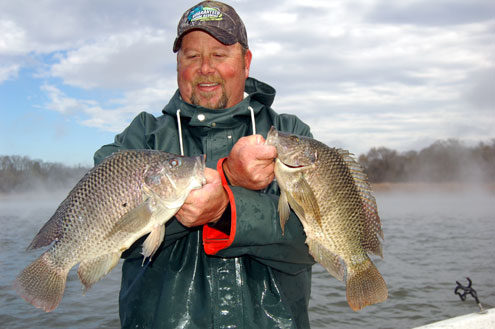
Next time you’re at the seafood market at your local grocery, chances are good you will see tilapia fillets, priced at several dollars per pounds. Tilapia is an excellent tasting fish that eats only vegetation, thus the reason they are seldom caught on conventional fishing tackle. TPWD stocked them heavily in Lake Fairfield years ago to help control the aquatic vegetation in this fertile little warm water reservoir situated a few miles from Fairfield, Texas. Tilapia need warm water and power plant lakes such as Fairfield provide the ideal habitat.
Lake Fairfield is chock full of these good-eating fish ... but don’t try to catch them with conventional tackle. I’ve heard reports of anglers using bits of broccoli on tiny treble hooks with success but never witnessed a tilapia caught on rod and reel. I have caught them in large numbers in a cast net (perfectly legal) and bowfished in the shallows with great success.
Guide Cory Vinson with Guaranteed Guide Service (www.nofishnocharge.com) guides trips for freshwater redfish at Fairfield and for his clients that enjoy eating fish, spends some time after the trip throwing the cast net for tilapia.
“We position the boat in shallow water at the mouth of the hot water discharge and usually a few throws of the cast net result in all that’s needed to catch a cooler full of tilapia,” says Vinson.

Vinson uses a larger cast net, a 6-footer I believe, which opens to 12 feet. Throwing nets this large requires a good bit of practice not to mention a good throwing arm. Four-foot cast nets (they open to eight feet) do a good job on tilapia and most folks can learn to throw these smaller diameter nets with a little practice. Vinson eases the boat along with the trolling motor on low speed and throws ahead of the boat into undisturbed fish. It’s not uncommon to catch four or more tilapia with one throw of the net and many of the fish weigh 3-6 pounds. It doesn’t take long to fill an ice cooler with these tasty fish this time of year.
Mark Balette is an avid bowhunter who enjoys using his archery tackle to harvest his tilapia for the freezer. You can shoot tilapia during daylight hours or using lights rigged on a bowfishing boat at night. Most tilapia are taken with archery equipment when they are spawning in the shallows.
"It’s tough to shoot them when they are in water much deeper than a couple of feet,” tips Balette.
Regardless if you go after your tilapia with a cast net, bow or, possibly a bit of broccoli on a treble hook, I can guarantee that after a successful trip, you will return home with some of the finest-eating fillets in fresh water.
Tilapia can be cooked in a variety of ways. I love them fried or baked. One of our favorite methods of preparing tilapia is to coat each side of the fillet with melted butter, then dust with your favorite dry seasonings (I prefer dry Country Bobs seasoning), and then roll in Ritz Cracker Crumbs and bake at 400 degrees for about 12 minutes, turning once to brown each side of the fillet. Squeeze some fresh lemon juice on the baked fish and serve with wild rice and steamed broccoli.
JAVELINA SEASON OPEN IN NORTH TEXAS - Regular readers of this column might remember an article I did a couple months ago on hunting at the Ranger Creek Ranch (www.rangercreekranch.com) up in Knox County. We were pleasantly surprised at the large number of javelinas in the area. Javelina season runs through the end of this month and offer sportsmen in north Texas an opportunity to hunt without driving to far west or south Texas. Hunts at Ranger Creek Ranch are bow only and crossbows can be used.
HOG HUNTING WITH NIGHT VISION - Wild hog guides Clark Osborne and Jed Dreer with Tactical Hog Control (www.tacticalhogcontrol.com) are offering exciting night-hunting for wild hogs using 3rd generation night vision goggles and rifle scopes. Hunts take place on large ranches in the Centerville-Madisonville area. For more information, call 936-581-2256.
***********************************************
FISHING HOTSPOTS
Guide Billy Kilpatrick lives on the shores of Lake Lavon and has guided here for crappie for many years. Billy reports good number of crappie are coming from water 30-45 feet deep, around manmade brush piles.
“We’re catching good numbers of keeper crappie, with fish up to 15 inches, using small live minnows and jigs around the deeper brush piles," says Kilpatrick. "During the winter months when water temperatures are in the high forties to low fifties, the bite is often very subtle, but, on some days, these fish have been extremely aggressive for this time of year, hitting baits like shallow water crappie during the spawn.”
The guide is also running trips at Lake Monticello in northeast Texas and catching regular limits.
“The channel catfish bite at Monticello is awesome right now," remarks Kilpatrick. "We’re limiting out on channel cats weighing between 1.5 and 3 pounds in less than two hours. We’re targeting the warm water side of the lake which at last check had a surface temperature of 71 degrees. We’re baiting a single hole with soured grain in water around 13 feet deep and never having to move the boat. Now is a great time to stock the freezer with these good eating catfish.” To reach guide Billy Kilpatrick, call 214-232-7847.
OUTDOOR TIP OF THE WEEK - If your shooting stops with the close of hunting seasons, make sure and give your firearm a thorough cleaning before storing it in the gun cabinet until next fall. Use a nylon brush designed for the caliber of your rifle and give the bore a good scrubbing with a quality bore solvent. Next, pull several patches through the bore until none of the residue is left on the patch. Lightly coat a patch with a good lubricant and coat the bore before storing the rifle. Likewise, apply a light coat of gun oil to the outside and action of your rifle.
If you are through shotgunning until next fall (no need to be, really, there’s the upcoming turkey season and clay targets to shoot throughout the summer) your smoothbore will also need a good cleaning. Most hunters can do a good job at home cleaning their over/under, side by side and pump shotguns but if you shoot an autoloader, it might be a good idea to take it to a knowledgeable gunsmith and have the piece disassembled and cleaned. Rubber O rings will be inspected and replaced as needed. Nothing worse than taking a rifle or shotgun out of the gun cabinet before the opener of season and discover it is not operating properly. A little maintenance now will prevent such a disappointment!